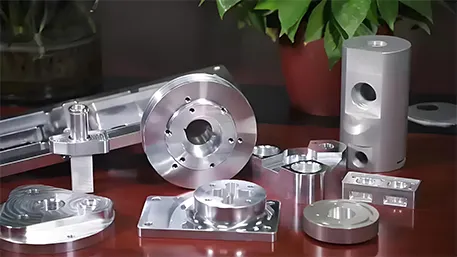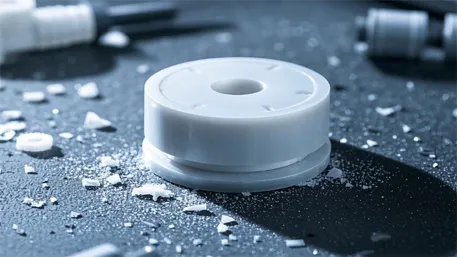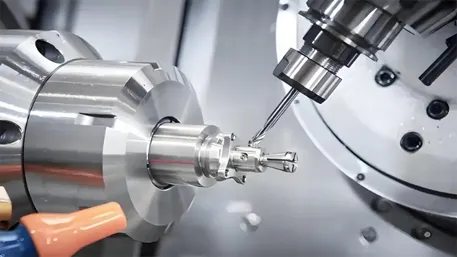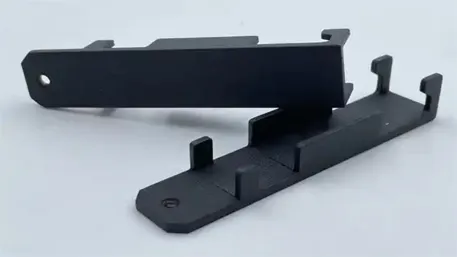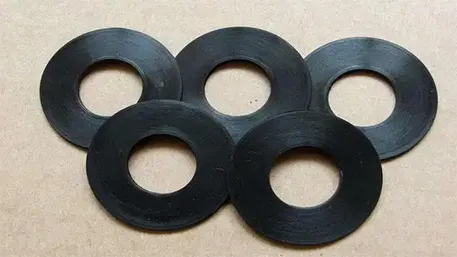In the ever – evolving manufacturing landscape, high – demand stainless steel CNC machining parts have emerged as essential components across a multitude of industries. Renowned for their exceptional corrosion resistance, strength, and versatility, these parts are crafted with precision through Computer Numerical Control (CNC) technology to meet the rigorous requirements of modern applications. This article delves into the technical capabilities, customization process, material characteristics, quality control measures, and industry applications of high – demand stainless steel CNC machining parts, highlighting their significance in driving innovation and reliability.
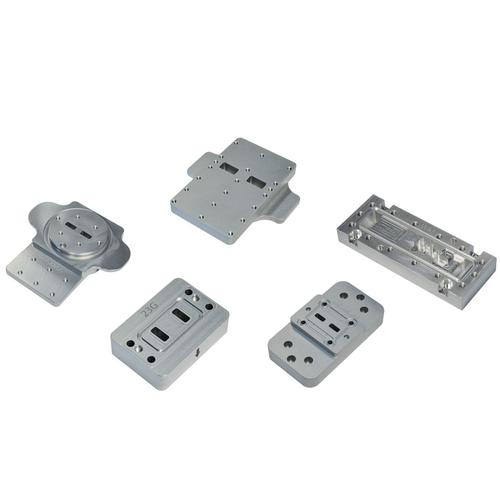
I. Technical Capabilities: Precision in Every Detail
(A) Ultra – High Dimensional Accuracy
CNC machining systems dedicated to stainless steel parts are meticulously calibrated to achieve outstanding dimensional accuracy. With positioning accuracy reaching ±0.002mm and repeat positioning accuracy of ±0.003mm, we can fabricate parts with extremely tight tolerances. For example, when manufacturing components for medical devices, such as surgical instruments or implantable parts, the critical dimensions like diameters, lengths, and internal passages need to be maintained within these precise limits. This level of accuracy ensures a perfect fit, optimal functionality, and patient safety.
(B) Complex Geometry Machining
Five – axis CNC machining technology enables the creation of stainless steel parts with highly intricate geometries. Whether it’s parts with complex internal channels for fluid flow in heat exchangers, organic – shaped components for architectural applications, or parts with multi – angled surfaces for aerospace equipment, the five – axis system can execute these designs with precision. Compared to traditional machining methods, five – axis CNC machining reduces setup – related errors from ±0.01mm to within ±0.003mm. Moreover, it boosts production efficiency by over 60%, allowing for the rapid manufacturing of high – demand stainless steel parts even with the most challenging designs.
(C) Advanced Machining Techniques for Stainless Steel
Stainless steel, while known for its durability, requires specialized machining techniques. CNC – controlled high – speed machining with optimized cutting parameters is used to prevent work – hardening, a common issue with stainless steel. Specialized cutting tools with advanced coatings, such as carbide – coated end mills, are employed to reduce friction and heat generation during machining, ensuring a smooth surface finish. Additionally, CNC – guided processes like electrochemical machining can be used for parts that require a mirror – like surface or intricate detailing.
II. End – to – End Customization: Tailored to Your Needs
(A) In – Depth Requirement Analysis and Design Conceptualization
When you approach us with your stainless steel part requirements, our experienced engineering team initiates detailed discussions to understand your application, performance expectations, and design preferences. We consider factors such as the operating environment (aggressive chemical exposure, high humidity, extreme temperatures), the mechanical loads the part will endure, and any specific functional or aesthetic requirements. Using state – of – the – art CAD/CAM software, we generate multiple design concepts. We then collaborate closely with you, refining the designs until they perfectly align with your vision, whether it’s a minor modification to a standard part or a completely new design for a specialized project.
(B) Strategic Material Selection and Cost Analysis
Based on the finalized design, we recommend the most suitable stainless steel alloys for your parts. Different stainless steel alloys offer varying combinations of properties. For example, 304 stainless steel is one of the most commonly used alloys, known for its good corrosion resistance, formability, and cost – effectiveness. It has a tensile strength of up to 515 MPa and is suitable for a wide range of applications, from food processing equipment to general industrial components. For more demanding environments, such as marine or chemical processing, 316 stainless steel, which contains molybdenum for enhanced corrosion resistance, is often the preferred choice. Simultaneously, we conduct a detailed cost analysis, factoring in material costs, machining complexity, and production volume, to provide you with a transparent and competitive quote.
(C) Precision Manufacturing and Order Tracking
Once you approve the design and quote, production commences. You can monitor the progress of your order in real – time through our dedicated online tracking platform. Our skilled technicians adhere to strict manufacturing standards, using advanced CNC turning, milling, drilling, and EDM (Electrical Discharge Machining) machines to produce stainless steel parts that meet the highest quality benchmarks. We keep you informed at every stage of the production process, from raw material procurement to the final inspection, ensuring complete transparency and peace of mind throughout the manufacturing journey.
(D) Rigorous Quality Assurance and Timely Delivery
After production, each custom stainless steel part undergoes a rigorous quality inspection. Only parts that meet our exacting standards are shipped to you. We perform dimensional inspections using coordinate measuring machines (CMMs) to ensure that all critical dimensions are within ±0.002mm. Surface finish measurements are taken to ensure that the surface meets the required roughness specifications for optimal functionality and aesthetics. In addition, we conduct mechanical tests, such as tensile strength testing, hardness testing, and corrosion resistance testing, to validate the performance of the parts. We also offer comprehensive after – sales support, addressing any concerns you may have during the product’s lifecycle and ensuring timely delivery to meet your production schedules.
III. Strategic Material Selection: Choosing the Right Stainless Steel Alloy
(A) 304 Stainless Steel
304 stainless steel, also known as 18/8 stainless steel due to its approximate 18% chromium and 8% nickel content, is a versatile alloy. It offers excellent corrosion resistance in normal atmospheric conditions and is resistant to many chemicals and foods. Its good formability allows for easy fabrication into various shapes, making it suitable for applications such as kitchen equipment, furniture, and architectural trim. With a relatively low cost compared to some other stainless steel alloys, 304 stainless steel provides a cost – effective solution for many high – demand parts.
(B) 316 Stainless Steel
316 stainless steel is often referred to as “marine – grade” stainless steel. The addition of molybdenum (around 2 – 3%) to the alloy composition significantly enhances its corrosion resistance, especially in chloride – rich environments. This makes it ideal for applications in marine environments, chemical processing plants, and medical equipment where exposure to harsh chemicals or bodily fluids is common. 316 stainless steel has similar mechanical properties to 304 stainless steel but offers superior protection against pitting and crevice corrosion.
(C) 430 Stainless Steel
430 stainless steel is a ferritic stainless steel with a lower nickel content compared to austenitic grades like 304 and 316. It has good corrosion resistance in mild environments and is magnetic, which can be an advantage in certain applications, such as magnetic separators. 430 stainless steel is often used in automotive trim, appliances, and decorative applications where cost – effectiveness and moderate corrosion resistance are required.
(D) Duplex Stainless Steels
Duplex stainless steels combine the properties of austenitic and ferritic stainless steels, offering high strength, excellent corrosion resistance, and good ductility. They are commonly used in applications where high mechanical strength and resistance to stress – corrosion cracking are essential, such as in oil and gas pipelines, pressure vessels, and offshore structures.
IV. Stringent Quality Control: Ensuring Excellence
(A) Raw Material Inspection
All incoming raw materials for stainless steel parts are subject to strict quality checks. We use spectroscopic analysis to verify the chemical composition of the alloys, ensuring that they meet the required standards. Additionally, hardness testing, tensile testing, and microstructure analysis are performed to ensure the material’s integrity and suitability for the intended application. For example, when using 316 stainless steel, we confirm that the molybdenum, chromium, and nickel contents are within the specified ranges.
(B) In – Process Monitoring
Throughout the manufacturing process, we employ statistical process control (SPC) techniques to monitor key manufacturing parameters. Regular sampling and data collection help us identify and correct any potential issues promptly. We monitor parameters such as cutting speeds, feed rates, tool wear, and the temperature during machining. In the case of heat – treatment processes (if applicable), we closely control temperature, time, and cooling rates. If any parameter deviates from the set values, we can adjust the process in real – time to ensure consistent product quality.
(C) Final Product Validation
Before shipping, each stainless steel part undergoes a comprehensive inspection. We use CMMs to verify dimensional accuracy, ensuring that all critical dimensions are within ±0.002mm. Surface roughness measurements are taken to ensure that the surface finish is optimized for the part’s intended function. Non – destructive testing methods, such as ultrasonic testing and dye penetrant inspection, are used to detect any internal or surface – breaking defects. Only parts that pass all these tests are considered ready for delivery.
V. Diverse Industry Applications: Meeting High – Demand Requirements
(A) Medical Industry
In the medical field, stainless steel CNC machining parts are widely used in surgical instruments, medical implants, and diagnostic equipment. The biocompatibility and corrosion resistance of stainless steel alloys like 316L (a low – carbon version of 316 stainless steel) make them suitable for direct contact with the human body. Precision – machined surgical instruments require tight tolerances to ensure accurate and safe procedures, while implants need to be precisely shaped for a proper fit and long – term functionality.
(B) Food and Beverage Industry
Stainless steel parts are essential in the food and beverage industry due to their hygiene and corrosion – resistant properties. From food processing equipment, such as mixers, conveyors, and storage tanks, to kitchen appliances, 304 and 316 stainless steel parts ensure that food products are not contaminated and can be stored and processed safely. The smooth surface finish of CNC – machined stainless steel parts also makes them easy to clean and maintain, meeting strict food safety standards.
(C) Marine and Offshore Industry
In the marine and offshore environment, where components are exposed to saltwater, humidity, and harsh weather conditions, stainless steel parts are highly sought after. 316 stainless steel is commonly used for shipbuilding, offshore platforms, and marine hardware due to its excellent corrosion resistance. CNC – machined parts, such as bolts, nuts, and structural components, are manufactured with precision to ensure the integrity and safety of marine structures.
(D) Chemical Processing Industry
The chemical processing industry requires components that can withstand exposure to a wide range of chemicals. Stainless steel alloys, especially 316 and higher – performance grades, are used for reactors, pipelines, valves, and pumps. CNC machining allows for the production of parts with complex geometries and tight tolerances, ensuring efficient chemical processing and preventing leaks or failures due to corrosion.
VI. Frequently Asked Questions (FAQ)
(A) What is the typical precision of high – demand stainless steel CNC machining parts?
Our CNC machining can achieve a dimensional tolerance of ±0.002mm, ensuring a precise fit and optimal performance in various applications.
(B) How long does it take to produce custom stainless steel parts?
Lead times vary depending on the complexity of the design, the materials used, and the order quantity. Simple designs can be completed in 3 – 5 days, while more complex ones may take 7 – 10 days. Rush orders are available upon request to meet urgent requirements.
(C) Can you customize stainless steel parts according to specific industry standards?
Yes, our team of experts is well – versed in various industry standards, such as ASTM, ASME, and ISO. We can customize stainless steel parts to meet or exceed these standards, ensuring compliance with your specific industry requirements.
(D) What are the surface finish options for stainless steel parts?
We offer a variety of surface finish options, including polished (mirror finish), brushed, bead – blasted, and electro – polished. The choice of surface finish depends on the application requirements, such as aesthetics, corrosion resistance, and ease of cleaning.
(E) How do you ensure the corrosion resistance of stainless steel parts?
In addition to using high – quality stainless steel alloys with excellent corrosion – resistant properties, we conduct rigorous corrosion resistance testing, such as salt spray testing and chemical immersion testing. Our manufacturing processes also minimize the risk of surface damage that could lead to corrosion, ensuring the long – term durability of the parts.
VII. Customer Testimonials
A leading medical device manufacturer approached us to develop custom 316L stainless steel components for their new line of surgical instruments. Our team utilized advanced CNC machining and material selection techniques to create parts that met the strict medical industry standards. The new components not only provided the required precision and biocompatibility but also reduced the risk of corrosion during sterilization processes. The manufacturer was highly satisfied with the quality and performance of our custom stainless steel parts, leading to a long – term partnership.
A food processing company needed custom stainless steel parts for their new production line. We designed and manufactured parts, including conveyor rollers and mixing blades, using 304 stainless steel and advanced CNC machining processes. The high – precision parts ensured smooth operation of the production line and easy cleaning, meeting the company’s strict hygiene requirements. The company reported increased production efficiency and reduced maintenance costs, thanks to the durable and reliable stainless steel parts.
Reach Out Now for Your High – Demand Stainless Steel CNC Machining Parts!
Whether you are in the medical, food and beverage, marine, chemical, or any other industry with high – demand for stainless steel parts, our team of experts is ready to provide you with high – quality, custom – made solutions. We offer a seamless end – to – end service, from design and material selection to manufacturing and quality assurance. Contact us today to discuss your project requirements and take the first step towards getting parts that will enhance the performance and reliability of your products.

